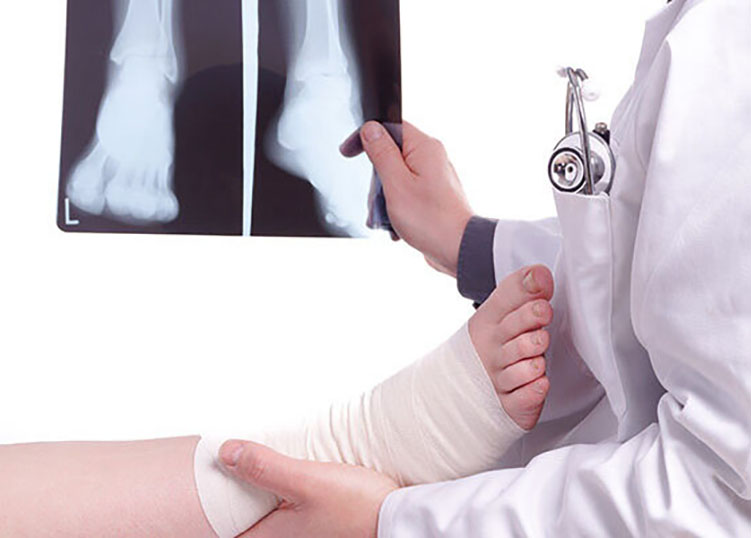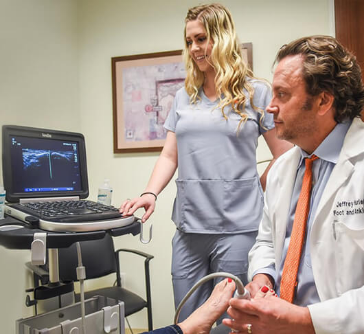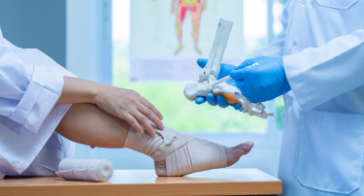
Schedule an Appointment
Toe and forefoot fractures are a frequent occurrence and can result from a variety of scenarios. These fractures often stem from a sudden, direct impact to the foot such as accidentally kicking an immovable object, or an item of significant weight falling on your foot. Furthermore, overuse injuries and repetitive stress, especially common in high-impact activities like running or playing basketball, can also result in a broken toe or forefoot.
Managing the pain from a broken toe can be challenging, and it's crucial to seek targeted treatment for broken toe pain promptly. Contrary to popular belief, a broken toe requires immediate attention and is not something to be disregarded. While these fractures are indeed painful, they seldom necessitate surgery.
In many instances, rest and a shift in physical activities can aid the healing process of a fracture. Nonetheless, for a broken bone injury, it's always prudent to seek professional medical attention to avoid long-term damage. If a fracture is "displaced" or "dislocated", urgent care for the broken bone becomes paramount to ensure proper realignment before healing begins.
When it comes to foot injuries, an emergency podiatrist can provide the necessary care and treatment. An emergency foot doctor can confirm the severity and exact location of the injury with an X-ray and guide you through the healing process. The early intervention and guidance from these experts can prevent potential permanent damage.
If you're faced with a broken bone injury, remember to act swiftly. The appropriate intervention and management by an emergency foot doctor can make a significant difference in your recovery process. It's your health on the line, so don't hesitate to seek urgent care for a broken bone to ensure optimal recovery and get you back on your feet.
Remember, your foot is a complex structure made up of numerous bones, and any damage can significantly affect your ability to move and carry out daily activities. That's why it's important to not underestimate a broken toe injury. Always prioritize your health and wellbeing. If you suspect you've broken a toe, immediately consult an emergency foot doctor or an emergency podiatrist. They can not only provide targeted treatment for broken toe pain but also monitor your healing process, ensuring that your foot regains its full function. With immediate, professional medical care, you can avoid long-term complications and resume your regular activities swiftly and safely.

Meet The Specialist
We practice a minimally invasive approach to your foot or ankle problem with surgery as the last option.

Call now

Location
425 Haaland Dr. #201 Thousand Oaks, CA 91361

Timing
9:00 AM to 6:00 PM (Sat-Sun by appointment)
Why Urgent Care for Feet

We can treat 90% of cases seen in an emergency room for a fraction of the cost.

All of our doctors have on average 15+ year of experience specializing in foot and ankle care.

We provide on site x-ray that is designed specifically for foot and ankle. This will avoid re-taking an x-ray done improperly at an ER or standard Urgent Care.
Frequently Asked Questions
A broken bone, also known as a fracture, occurs when the continuity of the bone is broken due to a high force impact or stress. This could be a result of accidents, falls, or conditions that weaken the bone, such as osteoporosis. Depending on the severity, fractures can be classified as simple (where the bone breaks but does not pierce the skin) or compound (where the broken bone punctures the skin). Common symptoms include intense pain, swelling, bruising, and inability to move the affected area. Immediate medical attention is essential for proper alignment and healing.
Symptoms of a broken bone can vary depending on the severity and location of the fracture, but often include:
-
Intense pain, often exacerbated by movement or pressure
-
Swelling and bruising around the injured area
-
Deformity, such as a limb appearing out of place or a bone protruding from the skin
-
Difficulty or inability to move the affected area
-
Numbness or tingling
-
In some cases, especially with more severe breaks, there may be shock or fainting
It's crucial to seek medical attention if a broken bone is suspected to ensure proper treatment and healing.
A broken bone is typically diagnosed through a physical examination and imaging tests. During the physical examination, the doctor will assess the injured area for tenderness, swelling, and deformity. However, because these signs could also indicate other types of injuries, imaging tests are usually necessary to confirm a fracture.
The most common imaging test is an X-ray, which can reveal most types of fractures. However, some fractures, especially those in the hip or stress fractures, may not immediately appear on X-rays. In such cases, other imaging tests like a CT scan, MRI, or bone scan may be used for a more detailed view.
Treatment for a broken bone depends on the type, location, and severity of the fracture. The primary goal is to ensure the broken pieces of bone are aligned properly (reduction) and stabilized during healing. Here are common treatment methods:
-
Immobilization: Casts or splints are typically used to keep the bone from moving while it heals. They maintain the bone in the correct position and protect it from further injury.
-
Medication: Pain relief is often necessary, and can range from over-the-counter painkillers to prescription medications, depending on the severity of the pain.
-
Surgery: In some cases, surgery is needed to align the bones correctly and stabilize the fracture. This can involve the use of metal plates, screws, or rods.
-
Physical Therapy: After the bone has healed, physical therapy exercises can help restore movement and strength to the affected area.
-
Traction: Traction might be used to align a bone or bones by a gentle, steady pulling action.
In all cases, it's essential to follow the healthcare provider's instructions and go for all follow-up appointments to ensure the bone is healing correctly.
The healing time for a broken bone varies widely depending on the type and location of the fracture, the patient's age and overall health, and how well the patient adheres to their treatment plan.
In general, most fractures in adults take about 6 to 8 weeks to heal. However, larger bones, such as the femur (thigh bone), may take longer, up to several months. In children, who often heal more quickly, a minor fracture could heal in as few as 3 weeks.
It's important to remember that even after the bone has healed, there may still be a period of rehabilitation as muscle strength and joint mobility are restored. This could also take several weeks or months. Always consult with your healthcare provider for specific timelines related to your individual situation.
While bones have the remarkable ability to heal themselves, a broken bone requires medical intervention to ensure it heals correctly. When a bone breaks, the body naturally starts the healing process. However, the bone fragments must be properly aligned (called reduction) and stabilized for this process to result in a functional, pain-free healing.
Without medical intervention, a broken bone could heal in a misaligned position, causing potential issues like chronic pain, limited movement, or improper function. In some cases, this can lead to lasting disability. Therefore, it's essential to seek medical care for a suspected fracture to ensure it is correctly aligned and stabilized for optimal healing.
A broken bone can lead to several potential complications, including:
-
Nonunion or delayed union: Sometimes, a broken bone does not heal (nonunion) or takes longer than usual to heal (delayed union).
-
Malunion: A bone may heal incorrectly or become misaligned, leading to possible long-term issues with movement and function.
-
Infection: This is especially common in open fractures where the broken bone pierces the skin.
-
Compartment syndrome: This is a painful condition that occurs when pressure within the muscles increases to dangerous levels, potentially leading to muscle and nerve damage.
-
Fat embolism: Though rare, this can occur when fat particles in the bone marrow enter the bloodstream and form a blockage.
-
Damage to nerves and blood vessels: Nearby nerves and blood vessels may be injured when a bone breaks, potentially leading to long-term complications.
To minimize the risk of these complications, it's essential to get immediate medical attention for a suspected fracture and to follow the prescribed treatment plan.
While it may be possible to move or use an area with a broken bone, it is generally not advisable to do so. Moving the broken bone can cause further injury, lead to improper healing, or increase pain. It's important to immobilize the injured area as soon as possible after the injury and seek immediate medical attention. A healthcare provider will properly set and stabilize the bone to promote proper healing. Once the bone begins to heal, guided physical therapy may be recommended to help restore function and strength. Always follow your healthcare provider's specific advice regarding movement and use of the injured area.
Distinguishing between a broken foot and a sprain can be difficult without medical evaluation as both injuries can cause similar symptoms such as pain, swelling, and bruising. However, certain signs might suggest a broken bone:
-
Deformity: A foot that looks out of place or has an abnormal bump or change in shape could indicate a fracture.
Intense pain that worsens with pressure or movement.
-
Difficulty or inability to bear weight or walk on the affected foot.
In severe cases, bone protrudes through the skin (though this is more rare).
A sprain, on the other hand, is damage to ligaments, not bones. It might cause similar symptoms but typically without significant deformity or the intense pain that comes with bearing weight.
Regardless of these signs, it's essential to seek immediate medical attention if you suspect a fracture or severe sprain. Only a healthcare professional can accurately diagnose the injury, often using imaging tests like X-rays. This ensures you receive appropriate treatment to facilitate healing and prevent potential complications.
Yes, you can visit an urgent care center for a foot fracture. These facilities are equipped to handle non-life-threatening injuries, including bone fractures. At an urgent care center, healthcare providers can perform physical examinations, conduct imaging tests such as X-rays to confirm the fracture, and provide initial treatment, which often involves immobilizing the foot with a splint or cast.
However, for more complex fractures or if surgery might be required, you may be referred to a specialist, such as an orthopedist or a podiatrist. Additionally, if the injury involves a severe open fracture (bone protruding through the skin) or is accompanied by other serious injuries, it's better to go directly to an emergency room. Always seek immediate medical attention for any suspected fracture to ensure proper treatment and healing.
If you visit an urgent care center with a suspected foot fracture, the healthcare provider will typically take the following steps:
-
Medical history and symptom review: The provider will ask about your symptoms, how the injury happened, and any relevant medical history.
-
Physical examination: The provider will examine the injured foot, looking for signs of a fracture such as swelling, bruising, deformity, or tenderness.
-
Imaging tests: If a fracture is suspected, the provider will likely order an X-ray to confirm the diagnosis and determine the type and severity of the fracture.
-
Initial treatment: If a fracture is confirmed, the initial treatment will usually involve immobilizing the foot with a splint or cast to prevent further injury and facilitate healing.
The provider might also recommend over-the-counter or prescription pain medication.
-
Referral: For more complex fractures, or if surgery might be required, the provider will likely refer you to a specialist such as an orthopedic surgeon or a podiatrist for further treatment.
Remember that each patient's case is unique, and the specific course of action can vary based on the individual situation. Always follow the specific advice given by the healthcare provider.
At an urgent care center, treatment for a foot fracture generally includes:
-
Pain Management: The provider will likely prescribe or recommend over-the-counter pain medications to manage the pain associated with the fracture.
-
Immobilization: To prevent further injury and promote healing, the foot will typically be immobilized using a splint or cast.
-
RICE Method: The provider may recommend rest, ice, compression, and elevation (RICE) to reduce pain and swelling.
-
Referral: For complex fractures or if there's a need for surgery, you may be referred to an orthopedic surgeon or a podiatrist for further treatment.
-
Follow-up Instructions: The provider will give you instructions on how to care for your injury at home, which may include keeping the area dry, avoiding weight-bearing activities, and when to come back for a follow-up appointment.
-
Physical Therapy: Once the bone has begun to heal, you may be referred to a physical therapist to help regain strength and mobility in the foot.
Remember that the exact course of treatment can vary depending on the nature and severity of the fracture, as well as your overall health. Always follow the specific advice and treatment plan given by your healthcare provider.
Yes, it is important to follow up with a doctor after an urgent care visit for a foot fracture.
The initial visit to the urgent care center will provide immediate treatment for your fracture. However, a follow-up appointment with a healthcare provider, usually an orthopedic surgeon or a podiatrist, is essential to ensure the bone is healing correctly. During the follow-up, the doctor will likely perform another physical exam and may take additional X-rays to assess the healing process.
They may also adjust your treatment plan, if necessary, which could involve changing your cast or moving from a cast to a special boot. If physical therapy is needed, they will provide a referral.
Remember, fractures can have complications if not monitored and treated properly. Following up with your doctor helps to prevent complications and ensures a proper and complete recovery. Always follow the advice of your healthcare provider regarding follow-up care.
Reviews
This place was the best. Last night I stubbed my toe in the middle of the night and I wasn’t sure if it was broken. I couldn’t even walk. I called and they got me in right away. They took x-rays and put me in a boot because my toe was broken. The office was great and they special in feet yay!
![]()
Caitlyn Meyer
I stepped on a piece of glass and thought I had removed it but every time I stepped down I could feel it. I called Urgent Care For Feet and was seen same day and the doctor removed the glass and the whole staff was great.
![]()

